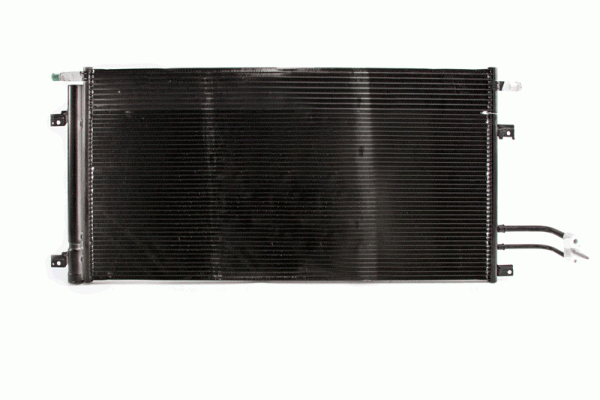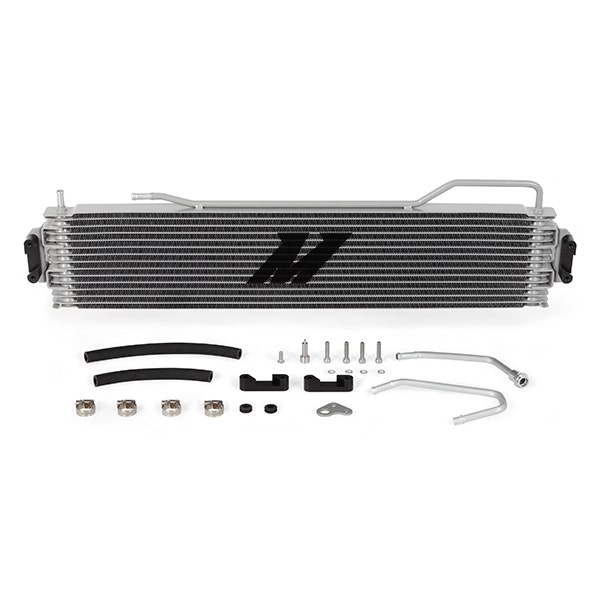
Layers of Cooling - Transmission Cooler R&D, Part 3: Testing
Trying something new can be a daunting, especially when you're changing something you've done well for a long time. In the case of our 2014+ Chevy/GMC K2 transmission cooler, the design of the stock transmission cooler had us stepping off the beaten path in search of the best possible solution.
In our previous posts, we discussed the design of the stock cooler that's integrated with the A/C condenser and how we would be adding an external cooler to supplement it. We had our core (the same one that we used on our Duramax project) mounted behind the grille of our volunteer K2, but we had no way of getting transmission fluid. This is where we really looked to challenge ourselves and raise the bar for the quality of aftermarket coolers.

Our plan was to intercept the ATF before it went to the stock transmission cooler. The path of fluid would be from the transmission to our cooler, and then to the stock cooler and back to the transmission or radiator. This would take a huge load off the stock coolers and help prevent over-cooling in the event the customer wanted to use the thermostatic bypass valve delete that will be included with our cooler.

The stock transmission cooler is connected to the transmission and radiator with hardlines and quick-disconnects. For our cooler to intercept the flow of fluid, we would need to connect those hardlines to our cooler's hose barbs. We could just slide some transmission hose over the stock hardlines and clamp it down, but the quick-disconnect ends weren't designed to hold a transmission hose. We would still need to find a way to route the hose to the cooler. Not to mention, we would also need an adapter to go from the transmission cooler hose to the quick-disconnect on the stock cooler. Since designing an adapter was unavoidable, we decided to make it as clean and simple as possible.

Our engineer designed two adapters that connect seamlessly to the hardlines. The first adapter has a female quick-disconnect on one end to connect to the stock transmission hardline. The other end of that adapter utilizes a barb design rated to hold well over the pressure generated by the transmission. The other adapter goes from that hose barb end to the stock male quick-disconnect end and connect our cooler back into the stock transmission cooler. Two small holes drilled in the plastic shrouding around the A/C condenser allow the adapters to bridge the gap between the stock cooler and ours.

The cooler was plumbed, and it was time for the part that most of you probably came here for: temperature testing. From previous projects, we've found that getting a truck transmission up to temperature on our DynaPacks can be challenging and doesn't always yield great scientific data. Road testing lets us load the transmissions more, but traffic and varying weather conditions often make getting apples-to-apples data nearly impossible. When we tested our 2nd Gen Ram Cummins transmission cooler, we developed a new way to gather consistent data that would allow us to compare the efficiency of our coolers versus their stock counterparts.

With the help of a vat of ATF heated to a constant temperature, an electric oil pump, and our variable-speed dyno fan, we began bench testing the two coolers. First up would be the stock cooler. Once the ATF reached operating temperature, we activated the oil pump and filled the stock cooler with hot ATF. After waiting for the fluid temp at the cooler's outlet to equal the inlet temp, we turned on the dyno fan and set it to produce the same wind speed seen behind the grille of the K2. The inlet and outlet temperatures fell (slightly) and eventually leveled off. We knew that we had reached the thermal efficiency of the stock cooler; it was no longer able to cool the ATF. We recorded the inlet and outlet temperatures for the stock cooler alone, then repeated the test with our cooler plumbed in before the stock cooler.
Our cooler adds an extra 0.65 quarts of fluid to the transmission cooling system and an extra 3,000 square-inches of cooling surface. We were confident that it would be a significant upgrade to the stock transmission cooler.

The data showed that our cooler was able to reduce inlet temps by about 10°F and outlet temps by a whopping 30°F when compared to the stock cooler alone. That's a 37% decrease in fluid temperature. And while the numbers on the chart below won't necessarily be the same numbers you see on your truck's trans temp gauge, we know from our Duramax transmission cooler that the efficiency shown in bench testing should be the same as on-road conditions, if not better.

Our temp testing confirmed that this project was ready to go from our engineering facility to your K2. With mass production under way, we're excited to announce that our 2014+ Chevy/GMC K2 V8 Transmission Cooler is now on discounted pre-sale. Now is your chance to get this awesome transmission cooler at a deep discount and prepare your K2 for a lifetime of hard work.
As always, feel free to let us know if you have any questions and thanks for reading!
-Steve











